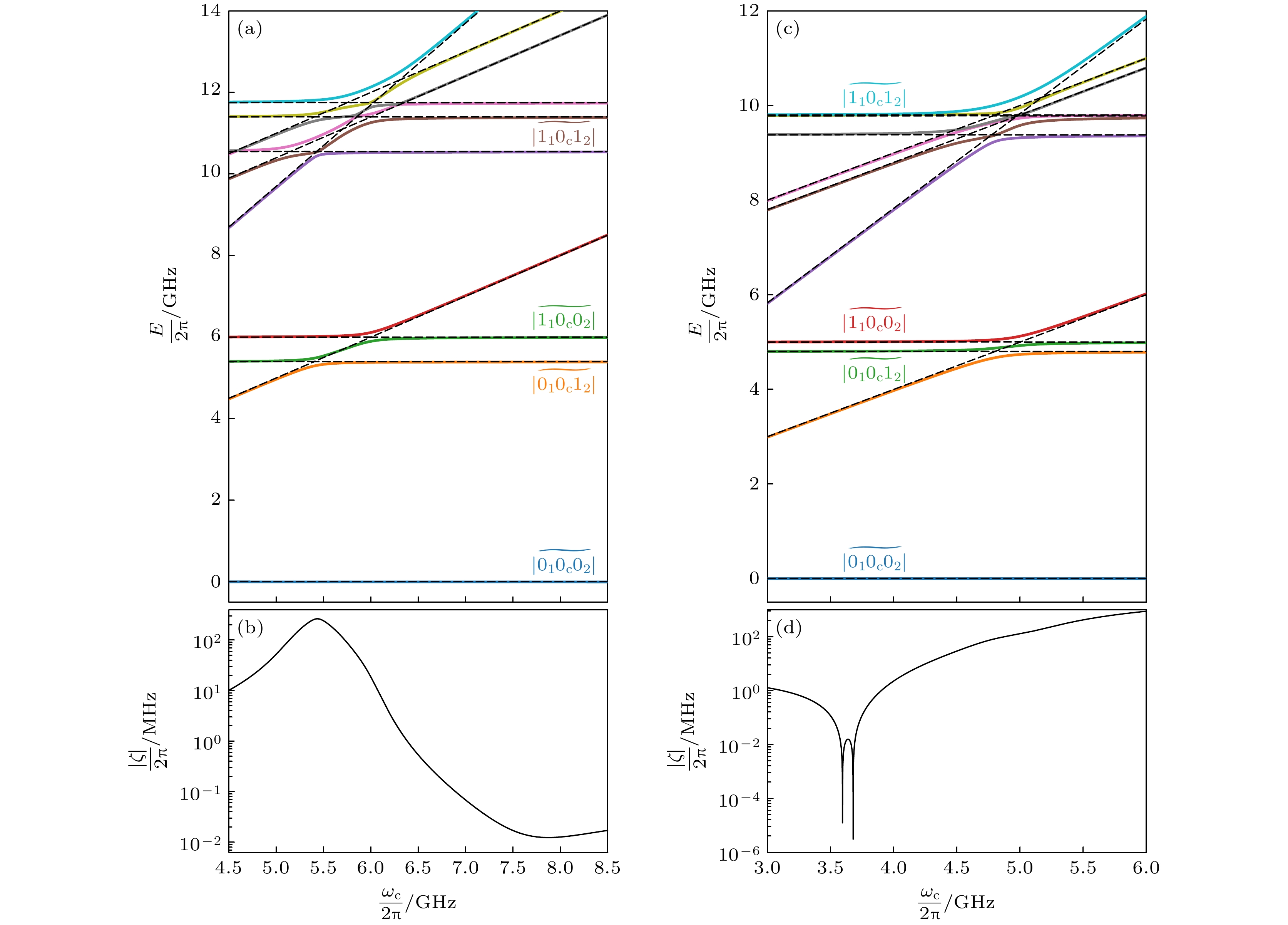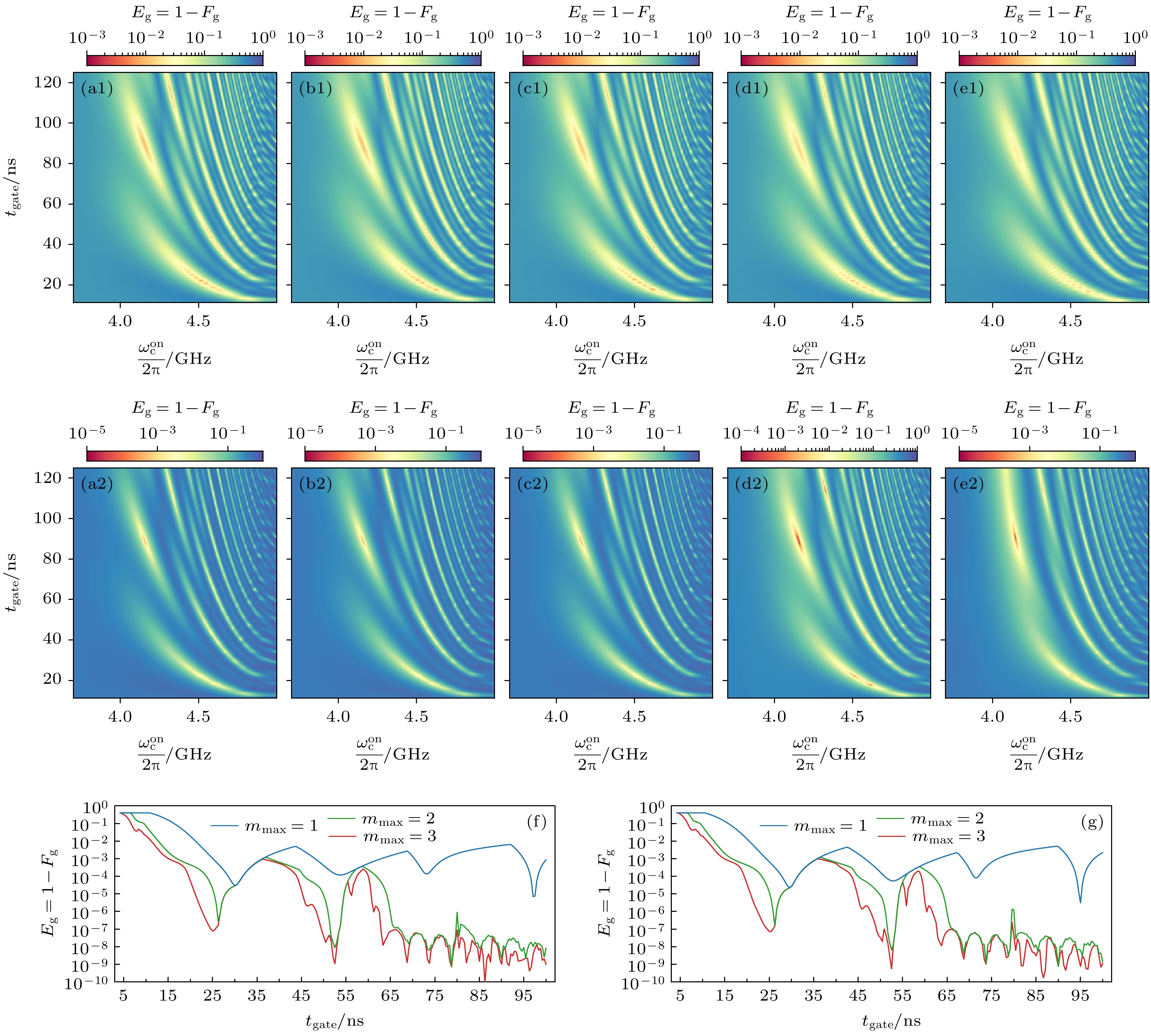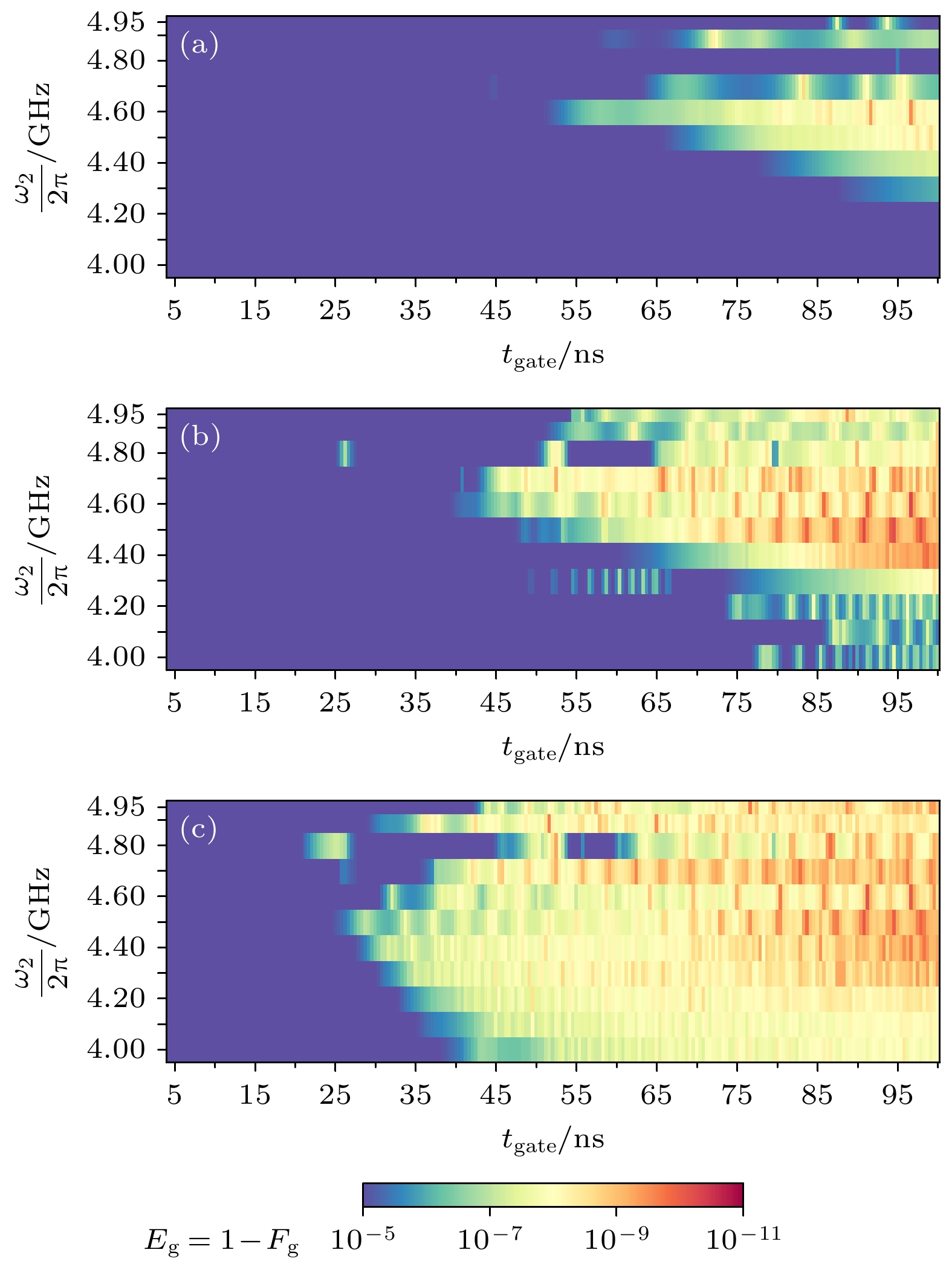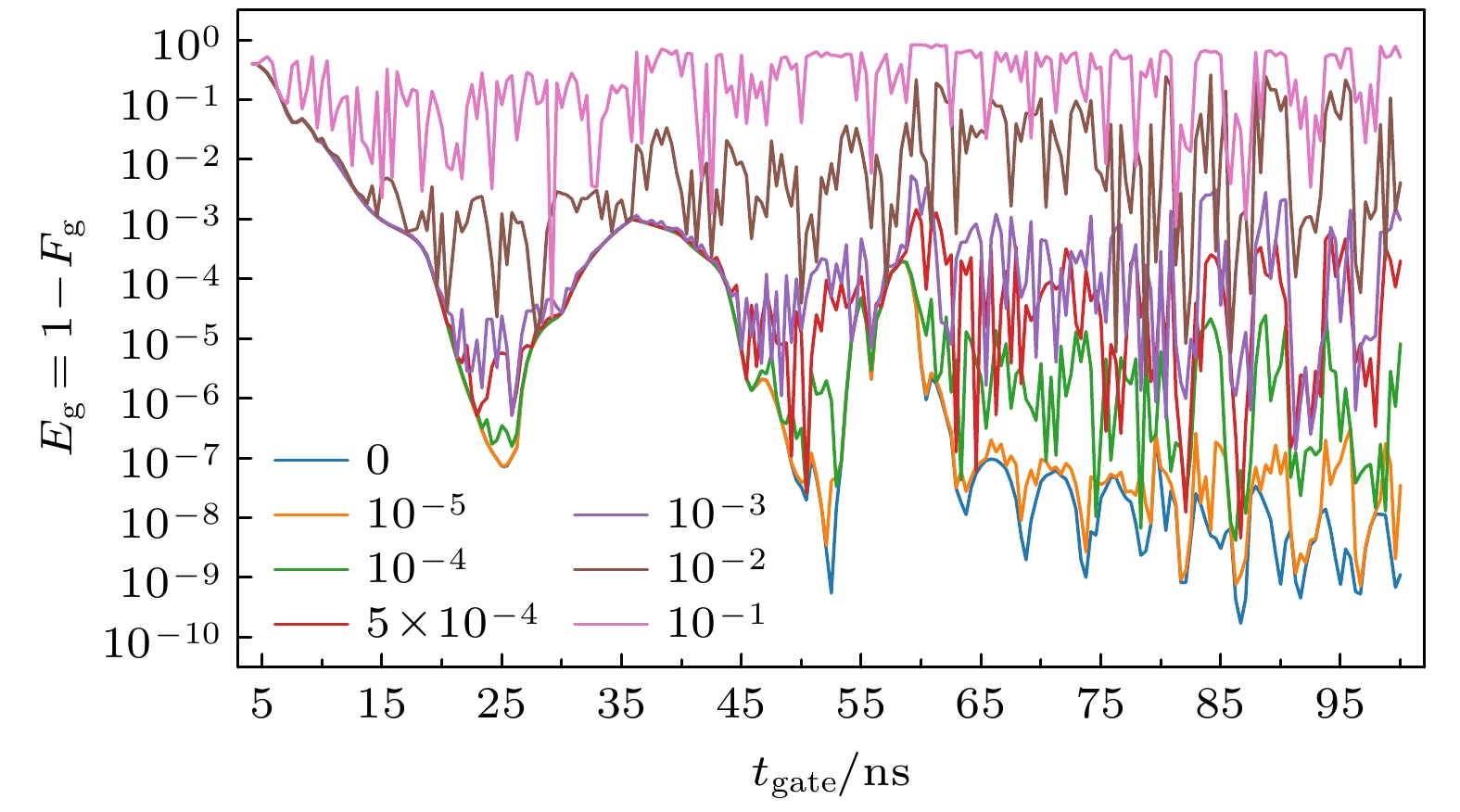-
Efficient and high-fidelity two-qubit gates are crucial to achieving fault-tolerant quantum computing and have become one of the key research topics in the quantum computing field. The fidelity of quantum gate is affected by many factors, such as quantum chip parameters and control waveforms. In theory, the chip paramters and waveforms can be precisely designed. However, in practice, the actual chip parameters and waveforms may deviate from the theoretical values. It is necessary to systematically study the effects of chip parameters, control waveforms, and other factors on the fidelity of two-qubit gate, and determine the magnitude and direction of the each factor’s effect. Here, we systematically study the effects of chip parameters, control waveforms, coupler start frequency, qubit frequency, etc. on the fidelity of CZ gate. On this basis, the response of gate fidelity to deviations in control parameters is further studied. At the chip design level, quantum chips based on CBQ parameters can achieve higher-fidelity CZ gate in shorter gate operation time. In terms of controlling waveforms, the three-level Fourier series wave is superior to the square wave and rounded trapezoidal wave in achieving lower gate error rate and shorter gate operation time, and can better meet the requirements for efficient implementation of high-fidelity quantum gates. Factors such as the coupler starting frequency and qubit frequency have relatively little effect on the fidelity of the CZ gate. In a wide frequency range, high-fidelity CZ gate can always be achieved by optimizing the control waveform parameters. It should be pointed out that slight deviations of control parameters will lead to a significant increase in gate error. This study is of great significance for clarifying the effects of various factors on the fidelity of the CZ gate. It can provide theoretical and technical support for designing superconducting quantum chips and realizing high-fidelity CZ gate, thereby promoting the engineering development of quantum computing.
-
Keywords:
- quantum computing /
- quantum gates /
- quantum control /
- fidelity
[1] Easttom C 2022 Modern Cryptography: Applied Mathematics for Encryption and Information Security (Cham: Springer International Publishing) pp397–407
[2] Hossain Faruk M J, Tahora S, Tasnim M, Shahriar H, Sakib N 2022 1st International Conference on AI in Cybersecurity Victoria, TX, USA, May 24–26, 2022 p1
[3] Cavaliere F, Mattsson J, Smeets B 2020 Network Security 2020 9
 Google Scholar
Google Scholar
[4] Biamonte J, Wittek P, Pancotti N, Rebentrost P, Wiebe N, Lloyd S 2017 Nature 549 195
 Google Scholar
Google Scholar
[5] Wang Y, Liu J 2024 Rep. Prog. Phys. 87 116402
 Google Scholar
Google Scholar
[6] Lanyon B P, Whitfield J D, Gillett G G, Goggin M E, Almeida M P, Kassal I, Biamonte J D, Mohseni M, Powell B J, Barbieri M, Aspuru-Guzik A, White A G 2010 Nat. Chem. 2 106
 Google Scholar
Google Scholar
[7] Cao Y, Romero J, Olson J P, Degroote M, Johnson P D, Kieferová M, Kivlichan I D, Menke T, Peropadre B, Sawaya N P D, Sim S, Veis L, Aspuru-Guzik A 2019 Chem. Rev. 119 10856
 Google Scholar
Google Scholar
[8] Orús R, Mugel S, Lizaso E 2019 Rev. Phys. 4 100028
 Google Scholar
Google Scholar
[9] Herman D, Googin C, Liu X, Sun Y, Galda A, Safro I, Pistoia M, Alexeev Y 2023 Nat. Rev. Phys. 5 450
 Google Scholar
Google Scholar
[10] Egger D J, Gambella C, Marecek J, McFaddin S, Mevissen M, Raymond R, Simonetto A, Woerner S, Yndurain E 2020 IEEE Transactions on Quantum Engineering 1 1
 Google Scholar
Google Scholar
[11] Preskill J 2018 Quantum 2 79
 Google Scholar
Google Scholar
[12] Aharonov D, Ben-Or M 2008 SIAM J. Comput. 38 1207
 Google Scholar
Google Scholar
[13] Knill E, Laflamme R, Zurek W H 1998 Science 279 342
 Google Scholar
Google Scholar
[14] Krinner S, Lacroix N, Remm A, Di Paolo A, Genois E, Leroux C, Hellings C, Lazar S, Swiadek F, Herrmann J, Norris G J, Andersen C K, Müller M, Blais A, Eichler C, Wallraff A 2022 Nature 605 669
 Google Scholar
Google Scholar
[15] Zhao Y, Ye Y, Huang H L, Zhang Y, Wu D, Guan H, Zhu Q, Wei Z, He T, Cao S, Chen F, Chung T H, Deng H, Fan D, Gong M, Guo C, Guo S, Han L, Li N, Li S, Li Y, Liang F, Lin J, Qian H, Rong H, Su H, Sun L, Wang S, Wu Y, Xu Y, Ying C, Yu J, Zha C, Zhang K, Huo Y H, Lu C Y, Peng C Z, Zhu X, Pan J W 2022 Phys. Rev. Lett. 129 030501
 Google Scholar
Google Scholar
[16] Google Quantum AI 2023 Nature 614 676
 Google Scholar
Google Scholar
[17] Gupta R S, Sundaresan N, Alexander T, Wood C J, Merkel S T, Healy M B, Hillenbrand M, Jochym-O'Connor T, Wootton J R, Yoder T J, Cross A W, Takita M, Brown B J 2024 Nature 625 259
 Google Scholar
Google Scholar
[18] Brock B L, Singh S, Eickbusch A, Sivak V V, Ding A Z, Frunzio L, Girvin S M, Devoret M H 2025 Nature 641 612
 Google Scholar
Google Scholar
[19] Babbush R, McClean J R, Newman M, Gidney C, Boixo S, Neven H 2021 PRX Quantum 2 010103
 Google Scholar
Google Scholar
[20] Litinski D 2019 Quantum 3 128
 Google Scholar
Google Scholar
[21] Fowler A G, Mariantoni M, Martinis J M, Cleland A N 2012 Phys. Rev. A 86 032324
 Google Scholar
Google Scholar
[22] Tomita Y, Svore K M 2014 Phys. Rev. A 90 062320
 Google Scholar
Google Scholar
[23] O’Brien T E, Tarasinski B, DiCarlo L 2017 npj Quantum Inf. 3 39
 Google Scholar
Google Scholar
[24] Raussendorf R, Harrington J 2007 Phys. Rev. Lett. 98 190504
 Google Scholar
Google Scholar
[25] Gao D, Fan D, Zha C, Bei J, Cai G, Cai J, Cao S, Chen F, Chen J, Chen K, Chen X, Chen X, Chen Z, Chen Z, Chen Z, Chu W, Deng H, Deng Z, Ding P, Ding X, Ding Z, Dong S, Dong Y, Fan B, Fu Y, Gao S, Ge L, Gong M, Gui J, Guo C, Guo S, Guo X, Han L, He T, Hong L, Hu Y, Huang H L, Huo Y H, Jiang T, Jiang Z, Jin H, Leng Y, Li D, Li D, Li F, Li J, Li J, Li J, Li J, Li N, Li S, Li W, Li Y, Li Y, Liang F, Liang X, Liao N, Lin J, Lin W, Liu D, Liu H, Liu M, Liu X, Liu X, Liu Y, Lou H, Ma Y, Meng L, Mou H, Nan K, Nie B, Nie M, Ning J, Niu L, Peng W, Qian H, Rong H, Rong T, Shen H, Shen Q, Su H, Su F, Sun C, Sun L, Sun T, Sun Y, Tan Y, Tan J, Tang L, Tu W, Wan C, Wang J, Wang B, Wang C, Wang C, Wang C, Wang J, Wang L, Wang R, Wang S, Wang X, Wang X, Wang X, Wang Y, Wei Z, Wei J, Wu D, Wu G, Wu J, Wu S, Wu Y, Xie S, Xin L, Xu Y, Xue C, Yan K, Yang W, Yang X, Yang Y, Ye Y, Ye Z, Ying C, Yu J, Yu Q, Yu W, Zeng X, Zhan S, Zhang F, Zhang H, Zhang K, Zhang P, Zhang W, Zhang Y, Zhang Y, Zhang L, Zhao G, Zhao P, Zhao X, Zhao X, Zhao Y, Zhao Z, Zheng L, Zhou F, Zhou L, Zhou N, Zhou N, Zhou S, Zhou S, Zhou Z, Zhu C, Zhu Q, Zou G, Zou H, Zhang Q, Lu C Y, Peng C Z, Zhu X, Pan J W 2025 Phys. Rev. Lett. 134 090601
 Google Scholar
Google Scholar
[26] Krantz P, Kjaergaard M, Yan F, Orlando T P, Gustavsson S, Oliver W D 2019 Appl. Phys. Rev. 6 021318
 Google Scholar
Google Scholar
[27] DiCarlo L, Chow J M, Gambetta J M, Bishop L S, Johnson B R, Schuster D I, Majer J, Blais A, Frunzio L, Girvin S M, Schoelkopf R J 2009 Nature 460 240
 Google Scholar
Google Scholar
[28] Dewes A, Ong F R, Schmitt V, Lauro R, Boulant N, Bertet P, Vion D, Esteve D 2012 Phys. Rev. Lett. 108 057002
 Google Scholar
Google Scholar
[29] Zhao P, Xu P, Lan D, Chu J, Tan X, Yu H, Yu Y 2020 Phys. Rev. Lett. 125 200503
 Google Scholar
Google Scholar
[30] Barends R, Quintana C M, Petukhov A G, Chen Y, Kafri D, Kechedzhi K, Collins R, Naaman O, Boixo S, Arute F, Arya K, Buell D, Burkett B, Chen Z, Chiaro B, Dunsworth A, Foxen B, Fowler A, Gidney C, Giustina M, Graff R, Huang T, Jeffrey E, Kelly J, Klimov P V, Kostritsa F, Landhuis D, Lucero E, McEwen M, Megrant A, Mi X, Mutus J, Neeley M, Neill C, Ostby E, Roushan P, Sank D, Satzinger K J, Vainsencher A, White T, Yao J, Yeh P, Zalcman A, Neven H, Smelyanskiy V N, Martinis J M 2019 Phys. Rev. Lett. 123 210501
 Google Scholar
Google Scholar
[31] Chen Y, Neill C, Roushan P, Leung N, Fang M, Barends R, Kelly J, Campbell B, Chen Z, Chiaro B, Dunsworth A, Jeffrey E, Megrant A, Mutus J Y, O'Malley P J J, Quintana C M, Sank D, Vainsencher A, Wenner J, White T C, Geller M R, Cleland A N, Martinis J M 2014 Phys. Rev. Lett. 113 220502
 Google Scholar
Google Scholar
[32] Foxen B, Neill C, Dunsworth A, Roushan P, Chiaro B, Megrant A, Kelly J, Chen Z, Satzinger K, Barends R, Arute F, Arya K, Babbush R, Bacon D, Bardin J C, Boixo S, Buell D, Burkett B, Chen Y, Collins R, Farhi E, Fowler A, Gidney C, Giustina M, Graff R, Harrigan M, Huang T, Isakov S V, Jeffrey E, Jiang Z, Kafri D, Kechedzhi K, Klimov P, Korotkov A, Kostritsa F, Landhuis D, Lucero E, McClean J, McEwen M, Mi X, Mohseni M, Mutus J Y, Naaman O, Neeley M, Niu M, Petukhov A, Quintana C, Rubin N, Sank D, Smelyanskiy V, Vainsencher A, White T C, Yao Z, Yeh P, Zalcman A, Neven H, Martinis J M 2020 Phys. Rev. Lett. 125 120504
 Google Scholar
Google Scholar
[33] Yan F, Krantz P, Sung Y, Kjaergaard M, Campbell D L, Orlando T P, Gustavsson S, Oliver W D 2018 Phys. Rev. Appl. 10 054062
 Google Scholar
Google Scholar
[34] Li X, Cai T, Yan H, Wang Z, Pan X, Ma Y, Cai W, Han J, Hua Z, Han X, Wu Y, Zhang H, Wang H, Song Y, Duan L, Sun L 2020 Phys. Rev. Appl. 14 024070
 Google Scholar
Google Scholar
[35] Sete E A, Chen A Q, Manenti R, Kulshreshtha S, Poletto S 2021 Phys. Rev. Appl. 15 064063
 Google Scholar
Google Scholar
[36] Setiawan F, Groszkowski P, Clerk A A 2023 Phys. Rev. Appl. 19 034071
 Google Scholar
Google Scholar
[37] Møller D, Madsen L B, Mølmer K 2008 Phys. Rev. Lett. 100 170504
 Google Scholar
Google Scholar
[38] Majer J, Chow J M, Gambetta J M, Koch J, Johnson B R, Schreier J A, Frunzio L, Schuster D I, Houck A A, Wallraff A, Blais A, Devoret M H, Girvin S M, Schoelkopf R J 2007 Nature 449 443
 Google Scholar
Google Scholar
[39] Chow J M, Gambetta J M, Cross A W, Merkel S T, Rigetti C, Steffen M 2013 New J. Phys. 15 115012
 Google Scholar
Google Scholar
[40] Rigetti C, Devoret M 2010 Phys. Rev. B 81 134507
 Google Scholar
Google Scholar
[41] Poletto S, Gambetta J M, Merkel S T, Smolin J A, Chow J M, Córcoles A D, Keefe G A, Rothwell M B, Rozen J R, Abraham D W, Rigetti C, Steffen M 2012 Phys. Rev. Lett. 109 240505
 Google Scholar
Google Scholar
[42] Caldwell S A, Didier N, Ryan C A, Sete E A, Hudson A, Karalekas P, Manenti R, da Silva M P, Sinclair R, Acala E, Alidoust N, Angeles J, Bestwick A, Block M, Bloom B, Bradley A, Bui C, Capelluto L, Chilcott R, Cordova J, Crossman G, Curtis M, Deshpande S, Bouayadi T E, Girshovich D, Hong S, Kuang K, Lenihan M, Manning T, Marchenkov A, Marshall J, Maydra R, Mohan Y, O'Brien W, Osborn C, Otterbach J, Papageorge A, Paquette J P, Pelstring M, Polloreno A, Prawiroatmodjo G, Rawat V, Reagor M, Renzas R, Rubin N, Russell D, Rust M, Scarabelli D, Scheer M, Selvanayagam M, Smith R, Staley A, Suska M, Tezak N, Thompson D C, To T W, Vahidpour M, Vodrahalli N, Whyland T, Yadav K, Zeng W, Rigetti C 2018 Phys. Rev. Appl. 10 034050
 Google Scholar
Google Scholar
[43] Paik H, Mezzacapo A, Sandberg M, McClure D T, Abdo B, Córcoles A D, Dial O, Bogorin D F, Plourde B L T, Steffen M, Cross A W, Gambetta J M, Chow J M 2016 Phys. Rev. Lett. 117 250502
 Google Scholar
Google Scholar
[44] Pedersen L H, Møller N M, Mølmer K 2007 Phys. Lett. A 367 47
 Google Scholar
Google Scholar
[45] Wales D J, Doye J P K 1997 J. Phys. Chem. A 101 5111
 Google Scholar
Google Scholar
[46] Chu J, Yan F 2021 Phys. Rev. Appl. 16 054020
 Google Scholar
Google Scholar
-
图 1 三种不同$ \omega_{{\mathrm{c}}}(t) $波形示意图 (a), (b)方波; (c), (d)圆角梯形波; (e), (f)傅里叶级数波. 图(a), (c)和(e)对应着$ \omega_{{\mathrm{c}}}^{{\rm{off}}} $ < $ \omega_{{\mathrm{c}}}^{{\rm{on}}} $的情形, 而图(b), (d)和(f)对应着$ \omega_{{\mathrm{c}}}^{{\rm{off}}} > \omega_{{\mathrm{c}}}^{{\rm{on}}} $的情形. 图(e)和(f)中的三条细虚线对应着傅里叶级数波形的三个分量: $ \omega_{{\mathrm{c}}}^{{\rm{off}}} + \lambda_{m} \left( 1 - \cos \dfrac{2 \pi m t}{t_{{\mathrm{gate}}}} \right),~ m=1, 2, 3 $
Figure 1. Schematic diagram of square pulse ((a), (b)), rounded-trapezoid-shaped pulse ((c), (d)) and Fourier-series pulse ((e), (f)). (a), (c) and (e) correspond to the case where $ \omega_{{\mathrm{c}}}^{{\rm{off}}} < \omega_{{\mathrm{c}}}^{{\rm{on}}} $, and (b), (d) and (f) correspond to the case where $ \omega_{{\mathrm{c}}}^{{\rm{off}}} > \omega_{{\mathrm{c}}}^{{\rm{on}}} $. The three thin dashed lines in (e) and (f) correspond to the three components of the Fourier series pulse: $ \omega_{{\mathrm{c}}}^{{\rm{off}}} + \lambda_{m} \left( 1 - \cos \dfrac{2 \pi m t}{t_{{\mathrm{gate}}}} \right), $$ ~ m=1, 2, 3 $.
图 2 哈密顿量H和$ H_{0} $的能谱((a), (c))以及ZZ相互作用$ \left\lvert \zeta \right\rvert /2 \pi $((b), (d))与耦合器频率$ \omega_{{\mathrm{c}}}/2\pi $的关系 (a), (b)对应CAQ模型参数; (c), (d)对应CBQ模型参数. 图(a)和(c)中的黑色虚线对应着无相互作用哈密顿量$ H_{0} $的本征能量, 彩色实线对应着系统哈密顿量H的本征能量
Figure 2. Energy-level spectra ((a), (c)) and ZZ interaction $ \left\lvert \zeta \right\rvert /2 \pi $ ((b), (d)) of the system Hamiltonian H as a function of the coupler frequency $ \omega_{{\mathrm{c}}}/2\pi $. Panels (a) and (b) correspond to the CAQ model parameters, and panels (c) and (d) correspond to the CBQ model parameters. The black dashed lines in panels (a) and (c) correspond to the eigen-energies of the non-interacting Hamiltonian $ H_{0} $, and the colored solid lines correspond to the eigen-energies of the system Hamiltonian H.
图 3 不同模型参数下的CZ门错误率. 图(a)和图(b)分别对应CAQ和CBQ两组模型参数. 图中蓝色、绿色和红色实线分别对应$ m_{\max} = 1, 2, 3 $三种不同的傅里叶级数波形
Figure 3. CZ gate errors under different model parameters. Panels (a) and (b) correspond to the CAQ and CBQ model parameters, respectively. The blue, green, and red solid lines in the panels correspond to three different Fourier series pulses with $ m_{\max} $ = 1, 2, and 3, respectively.
图 4 (a)方波对应的CZ门错误率; (b)圆角梯形波对应的CZ门错误率; 傅里叶级数波对应的CZ门错误率见图3(b). (a), (b)和图3(b)均是采用CBQ模型参数计算所得
Figure 4. (a) CZ gate errors under square pulse; (b) CZ gate errors under rounded-trapezoid-shaped pulse. CZ gate errors under Fourier-series pulse is shown in Fig. 3(b). Both (a), (b) and Fig. 3(b) are calculated using CBQ model parameters.
图 5 不同$ \omega_{{\mathrm{c}}}^{{\rm{off}}} $下的CZ门错误率. 每一行的五张子图((a1)—(e1)以及(a2)—(e2))对应的$ \omega_{{\mathrm{c}}}^{{\rm{off}}} $分别为3594, 3636, 3678, 3800和4000 MHz, 其他参数同CBQ模型参数. (a1)—(e1)的门错误率是使用$ H_{0} $的本征态计算的, 见(11)式; (a2)—(e2)的门错误率是使用系统哈密顿量H的本征态计算的, 见(12)式. (f)和(g)是采用傅里叶级数波形时的门错误率, 分别对应$ \omega_{{\mathrm{c}}}^{{\rm{off}}} =$ 3594, 3678 MHz
Figure 5. CZ gate errors rate under different $ \omega_{{\mathrm{c}}}^{{\rm{off}}} $. The corresponding $ \omega_{{\mathrm{c}}}^{{\rm{off}}} $ of the five sub-figures ((a1)–(e1) and (a2)–(e2)) in each row are 3594, 3636, 3678, 3800, 4000 MHz, respectively, other model paramters are the same as CBQ. The gate errors in (a1)–(e1) are calculated using the eigenstates of $ H_{0} $, see Eq. (11); (a2)–(e2) are calculated using the eigenstates of H, see Eq. (12). (f) and (g) are the gate error rates with Fourier series pulse, $ \omega_{{\mathrm{c}}}^{{\rm{off}}} = $ 3594, 3678 MHz, respectively.
图 6 不同量子比特频率$ \omega_{2} $下的CZ门错误率, 横轴是门操作时间$ t_{{\mathrm{gate}}} $, 纵轴是量子比特$ Q_{2} $的比特频率$ \omega_{2} $, 一共选取了$ \omega_{2} / 2 \pi = $ 4.0, 4.1, 4.2, 4.3, 4.4, 4.5, 4.6, 4.7, 4.8, 4.9, 4.95 GHz共11个不同的$ \omega_{2} $值, 其他模型参数同CBQ模型参数. (a)—(c)分别对应傅里叶分量数目$ m_{\max} = $ 1, 2, 3的情形
Figure 6. CZ gate error under different qubit frequencies $ \omega_{2} $. The horizontal axis is the gate operation time $ t_{{\mathrm{gate}}} $, and the vertical axis is the qubit frequency $ \omega_{2} $ of the $ Q_{2} $. A total of 11 different $ \omega_{2} $ values are selected, including $ \omega_{2} / 2 \pi = $ 4.0, 4.1, 4.2, 4.3, 4.4, 4.5, 4.6, 4.7, 4.8, 4.9, 4.95 GHz. Other model parameters are the same as the CBQ model parameters. (a)−(c) $ m_{\max} = $ 1, 2, 3
表 1 本文选取的两组模型参数, 分别标记为CAQ和CBQ
Table 1. Two sets of model parameters used in this paper, marked as CAQ and CBQ respectively.
模型参数 CAQ CBQ $ \rho_{1 {\mathrm{c}}} $ 0.0180 0.0220 $ \rho_{2 {\mathrm{c}}} $ 0.0180 –0.0220 $ \rho_{12} $ 0.0015 0.0013 $ \dfrac{\omega_{1}}{2 \pi} /{\rm{GHz}} $ 6.0 5.0 $ \dfrac{\omega_{2}}{2 \pi}/{\rm{GHz}} $ 5.4 4.8 $ \dfrac{\alpha_{1}}{2 \pi}/{\rm{MHz}} $ –250.0 –220.0 $ \dfrac{\alpha_{2}}{2 \pi}/{\rm{MHz}} $ –250.0 –220.0 $ \dfrac{\alpha_{\rm c}}{2 \pi} /{\rm{MHz}} $ –300.0 –170.0 表 2 不同$ \omega_{{\mathrm{c}}}^{{\rm{off}}} $下的CZ门错误率
Table 2. CZ gate errors rate under different $ \omega_{{\mathrm{c}}}^{{\rm{off}}} $.
$ \omega_{{\mathrm{c}}}^{{\rm{off}}} $/MHz Bare Dressed $ t_{{\mathrm{gate}}}/{\mathrm{ns}} $ $ \omega_{{\mathrm{c}}}^{{\rm{on}}} $/MHz $ E_{{\mathrm{g}}} $ $ t_{{\mathrm{gate}}}/{\mathrm{ns}} $ $ \omega_{{\mathrm{c}}}^{{\rm{on}}} $/MHz $ E_{{\mathrm{g}}} $ 3594 53/2.4 4514.0 7.2431×10–3 43/2.4 4615.5 5.9816×10–4 104/2.4 4582.5 9.1781×10–3 93/2.4 4623.5 1.6110×10–3 220/2.4 4144.0 5.5215×10–3 212/2.4 4159.0 2.4819×10–4 272/2.4 4327.5 5.1956×10–3 273/2.4 4326.0 8.4726×10–5 3636 54/2.4 4505.0 7.4825×10–3 43/2.4 4614.5 5.0617×10–4 114/2.4 4548.5 9.7407×10–3 93/2.4 4623.5 1.4097×10–4 220/2.4 4141.5 6.0894×10–3 212/2.4 4158.5 2.3052×10–4 272/2.4 4325.5 6.0173×10–3 273/2.4 4326.0 7.3497×10–5 3678 43/2.4 4612.5 7.3516×10–3 43/2.4 4613.5 4.4968×10–4 102/2.4 4587.5 6.6712×10–3 93/2.4 4623.5 1.2503×10–3 209/2.4 4163.0 6.3633×10–3 213/2.4 4156.5 2.1617×10–4 273/2.4 4325.5 6.2150×10–3 273/2.4 4326.0 8.0159×10–5 3800 41/2.4 4624.0 8.2440×10–3 43/2.4 4610.5 4.9159×10–4 101/2.4 4590.0 8.6945×10–3 93/2.4 4622.0 1.0150×10–3 209/2.4 4154.0 7.6224×10–3 213/2.4 4155.5 1.7852×10–4 271/2.4 4323.5 7.8218×10–3 273/2.4 4325.5 1.0117×10–5 4000 40/2.4 4610.0 1.0993×10–2 53/2.4 4508.0 5.3763×10–4 100/2.4 4584.5 6.1489×10–3 105/2.4 4576.0 9.3363×10–4 208/2.4 4148.0 1.1798×10–2 218/2.4 4144.5 2.4616×10–5 273/2.4 4318.0 1.1304×10–2 274/2.4 4322.5 3.1172×10–4 -
[1] Easttom C 2022 Modern Cryptography: Applied Mathematics for Encryption and Information Security (Cham: Springer International Publishing) pp397–407
[2] Hossain Faruk M J, Tahora S, Tasnim M, Shahriar H, Sakib N 2022 1st International Conference on AI in Cybersecurity Victoria, TX, USA, May 24–26, 2022 p1
[3] Cavaliere F, Mattsson J, Smeets B 2020 Network Security 2020 9
 Google Scholar
Google Scholar
[4] Biamonte J, Wittek P, Pancotti N, Rebentrost P, Wiebe N, Lloyd S 2017 Nature 549 195
 Google Scholar
Google Scholar
[5] Wang Y, Liu J 2024 Rep. Prog. Phys. 87 116402
 Google Scholar
Google Scholar
[6] Lanyon B P, Whitfield J D, Gillett G G, Goggin M E, Almeida M P, Kassal I, Biamonte J D, Mohseni M, Powell B J, Barbieri M, Aspuru-Guzik A, White A G 2010 Nat. Chem. 2 106
 Google Scholar
Google Scholar
[7] Cao Y, Romero J, Olson J P, Degroote M, Johnson P D, Kieferová M, Kivlichan I D, Menke T, Peropadre B, Sawaya N P D, Sim S, Veis L, Aspuru-Guzik A 2019 Chem. Rev. 119 10856
 Google Scholar
Google Scholar
[8] Orús R, Mugel S, Lizaso E 2019 Rev. Phys. 4 100028
 Google Scholar
Google Scholar
[9] Herman D, Googin C, Liu X, Sun Y, Galda A, Safro I, Pistoia M, Alexeev Y 2023 Nat. Rev. Phys. 5 450
 Google Scholar
Google Scholar
[10] Egger D J, Gambella C, Marecek J, McFaddin S, Mevissen M, Raymond R, Simonetto A, Woerner S, Yndurain E 2020 IEEE Transactions on Quantum Engineering 1 1
 Google Scholar
Google Scholar
[11] Preskill J 2018 Quantum 2 79
 Google Scholar
Google Scholar
[12] Aharonov D, Ben-Or M 2008 SIAM J. Comput. 38 1207
 Google Scholar
Google Scholar
[13] Knill E, Laflamme R, Zurek W H 1998 Science 279 342
 Google Scholar
Google Scholar
[14] Krinner S, Lacroix N, Remm A, Di Paolo A, Genois E, Leroux C, Hellings C, Lazar S, Swiadek F, Herrmann J, Norris G J, Andersen C K, Müller M, Blais A, Eichler C, Wallraff A 2022 Nature 605 669
 Google Scholar
Google Scholar
[15] Zhao Y, Ye Y, Huang H L, Zhang Y, Wu D, Guan H, Zhu Q, Wei Z, He T, Cao S, Chen F, Chung T H, Deng H, Fan D, Gong M, Guo C, Guo S, Han L, Li N, Li S, Li Y, Liang F, Lin J, Qian H, Rong H, Su H, Sun L, Wang S, Wu Y, Xu Y, Ying C, Yu J, Zha C, Zhang K, Huo Y H, Lu C Y, Peng C Z, Zhu X, Pan J W 2022 Phys. Rev. Lett. 129 030501
 Google Scholar
Google Scholar
[16] Google Quantum AI 2023 Nature 614 676
 Google Scholar
Google Scholar
[17] Gupta R S, Sundaresan N, Alexander T, Wood C J, Merkel S T, Healy M B, Hillenbrand M, Jochym-O'Connor T, Wootton J R, Yoder T J, Cross A W, Takita M, Brown B J 2024 Nature 625 259
 Google Scholar
Google Scholar
[18] Brock B L, Singh S, Eickbusch A, Sivak V V, Ding A Z, Frunzio L, Girvin S M, Devoret M H 2025 Nature 641 612
 Google Scholar
Google Scholar
[19] Babbush R, McClean J R, Newman M, Gidney C, Boixo S, Neven H 2021 PRX Quantum 2 010103
 Google Scholar
Google Scholar
[20] Litinski D 2019 Quantum 3 128
 Google Scholar
Google Scholar
[21] Fowler A G, Mariantoni M, Martinis J M, Cleland A N 2012 Phys. Rev. A 86 032324
 Google Scholar
Google Scholar
[22] Tomita Y, Svore K M 2014 Phys. Rev. A 90 062320
 Google Scholar
Google Scholar
[23] O’Brien T E, Tarasinski B, DiCarlo L 2017 npj Quantum Inf. 3 39
 Google Scholar
Google Scholar
[24] Raussendorf R, Harrington J 2007 Phys. Rev. Lett. 98 190504
 Google Scholar
Google Scholar
[25] Gao D, Fan D, Zha C, Bei J, Cai G, Cai J, Cao S, Chen F, Chen J, Chen K, Chen X, Chen X, Chen Z, Chen Z, Chen Z, Chu W, Deng H, Deng Z, Ding P, Ding X, Ding Z, Dong S, Dong Y, Fan B, Fu Y, Gao S, Ge L, Gong M, Gui J, Guo C, Guo S, Guo X, Han L, He T, Hong L, Hu Y, Huang H L, Huo Y H, Jiang T, Jiang Z, Jin H, Leng Y, Li D, Li D, Li F, Li J, Li J, Li J, Li J, Li N, Li S, Li W, Li Y, Li Y, Liang F, Liang X, Liao N, Lin J, Lin W, Liu D, Liu H, Liu M, Liu X, Liu X, Liu Y, Lou H, Ma Y, Meng L, Mou H, Nan K, Nie B, Nie M, Ning J, Niu L, Peng W, Qian H, Rong H, Rong T, Shen H, Shen Q, Su H, Su F, Sun C, Sun L, Sun T, Sun Y, Tan Y, Tan J, Tang L, Tu W, Wan C, Wang J, Wang B, Wang C, Wang C, Wang C, Wang J, Wang L, Wang R, Wang S, Wang X, Wang X, Wang X, Wang Y, Wei Z, Wei J, Wu D, Wu G, Wu J, Wu S, Wu Y, Xie S, Xin L, Xu Y, Xue C, Yan K, Yang W, Yang X, Yang Y, Ye Y, Ye Z, Ying C, Yu J, Yu Q, Yu W, Zeng X, Zhan S, Zhang F, Zhang H, Zhang K, Zhang P, Zhang W, Zhang Y, Zhang Y, Zhang L, Zhao G, Zhao P, Zhao X, Zhao X, Zhao Y, Zhao Z, Zheng L, Zhou F, Zhou L, Zhou N, Zhou N, Zhou S, Zhou S, Zhou Z, Zhu C, Zhu Q, Zou G, Zou H, Zhang Q, Lu C Y, Peng C Z, Zhu X, Pan J W 2025 Phys. Rev. Lett. 134 090601
 Google Scholar
Google Scholar
[26] Krantz P, Kjaergaard M, Yan F, Orlando T P, Gustavsson S, Oliver W D 2019 Appl. Phys. Rev. 6 021318
 Google Scholar
Google Scholar
[27] DiCarlo L, Chow J M, Gambetta J M, Bishop L S, Johnson B R, Schuster D I, Majer J, Blais A, Frunzio L, Girvin S M, Schoelkopf R J 2009 Nature 460 240
 Google Scholar
Google Scholar
[28] Dewes A, Ong F R, Schmitt V, Lauro R, Boulant N, Bertet P, Vion D, Esteve D 2012 Phys. Rev. Lett. 108 057002
 Google Scholar
Google Scholar
[29] Zhao P, Xu P, Lan D, Chu J, Tan X, Yu H, Yu Y 2020 Phys. Rev. Lett. 125 200503
 Google Scholar
Google Scholar
[30] Barends R, Quintana C M, Petukhov A G, Chen Y, Kafri D, Kechedzhi K, Collins R, Naaman O, Boixo S, Arute F, Arya K, Buell D, Burkett B, Chen Z, Chiaro B, Dunsworth A, Foxen B, Fowler A, Gidney C, Giustina M, Graff R, Huang T, Jeffrey E, Kelly J, Klimov P V, Kostritsa F, Landhuis D, Lucero E, McEwen M, Megrant A, Mi X, Mutus J, Neeley M, Neill C, Ostby E, Roushan P, Sank D, Satzinger K J, Vainsencher A, White T, Yao J, Yeh P, Zalcman A, Neven H, Smelyanskiy V N, Martinis J M 2019 Phys. Rev. Lett. 123 210501
 Google Scholar
Google Scholar
[31] Chen Y, Neill C, Roushan P, Leung N, Fang M, Barends R, Kelly J, Campbell B, Chen Z, Chiaro B, Dunsworth A, Jeffrey E, Megrant A, Mutus J Y, O'Malley P J J, Quintana C M, Sank D, Vainsencher A, Wenner J, White T C, Geller M R, Cleland A N, Martinis J M 2014 Phys. Rev. Lett. 113 220502
 Google Scholar
Google Scholar
[32] Foxen B, Neill C, Dunsworth A, Roushan P, Chiaro B, Megrant A, Kelly J, Chen Z, Satzinger K, Barends R, Arute F, Arya K, Babbush R, Bacon D, Bardin J C, Boixo S, Buell D, Burkett B, Chen Y, Collins R, Farhi E, Fowler A, Gidney C, Giustina M, Graff R, Harrigan M, Huang T, Isakov S V, Jeffrey E, Jiang Z, Kafri D, Kechedzhi K, Klimov P, Korotkov A, Kostritsa F, Landhuis D, Lucero E, McClean J, McEwen M, Mi X, Mohseni M, Mutus J Y, Naaman O, Neeley M, Niu M, Petukhov A, Quintana C, Rubin N, Sank D, Smelyanskiy V, Vainsencher A, White T C, Yao Z, Yeh P, Zalcman A, Neven H, Martinis J M 2020 Phys. Rev. Lett. 125 120504
 Google Scholar
Google Scholar
[33] Yan F, Krantz P, Sung Y, Kjaergaard M, Campbell D L, Orlando T P, Gustavsson S, Oliver W D 2018 Phys. Rev. Appl. 10 054062
 Google Scholar
Google Scholar
[34] Li X, Cai T, Yan H, Wang Z, Pan X, Ma Y, Cai W, Han J, Hua Z, Han X, Wu Y, Zhang H, Wang H, Song Y, Duan L, Sun L 2020 Phys. Rev. Appl. 14 024070
 Google Scholar
Google Scholar
[35] Sete E A, Chen A Q, Manenti R, Kulshreshtha S, Poletto S 2021 Phys. Rev. Appl. 15 064063
 Google Scholar
Google Scholar
[36] Setiawan F, Groszkowski P, Clerk A A 2023 Phys. Rev. Appl. 19 034071
 Google Scholar
Google Scholar
[37] Møller D, Madsen L B, Mølmer K 2008 Phys. Rev. Lett. 100 170504
 Google Scholar
Google Scholar
[38] Majer J, Chow J M, Gambetta J M, Koch J, Johnson B R, Schreier J A, Frunzio L, Schuster D I, Houck A A, Wallraff A, Blais A, Devoret M H, Girvin S M, Schoelkopf R J 2007 Nature 449 443
 Google Scholar
Google Scholar
[39] Chow J M, Gambetta J M, Cross A W, Merkel S T, Rigetti C, Steffen M 2013 New J. Phys. 15 115012
 Google Scholar
Google Scholar
[40] Rigetti C, Devoret M 2010 Phys. Rev. B 81 134507
 Google Scholar
Google Scholar
[41] Poletto S, Gambetta J M, Merkel S T, Smolin J A, Chow J M, Córcoles A D, Keefe G A, Rothwell M B, Rozen J R, Abraham D W, Rigetti C, Steffen M 2012 Phys. Rev. Lett. 109 240505
 Google Scholar
Google Scholar
[42] Caldwell S A, Didier N, Ryan C A, Sete E A, Hudson A, Karalekas P, Manenti R, da Silva M P, Sinclair R, Acala E, Alidoust N, Angeles J, Bestwick A, Block M, Bloom B, Bradley A, Bui C, Capelluto L, Chilcott R, Cordova J, Crossman G, Curtis M, Deshpande S, Bouayadi T E, Girshovich D, Hong S, Kuang K, Lenihan M, Manning T, Marchenkov A, Marshall J, Maydra R, Mohan Y, O'Brien W, Osborn C, Otterbach J, Papageorge A, Paquette J P, Pelstring M, Polloreno A, Prawiroatmodjo G, Rawat V, Reagor M, Renzas R, Rubin N, Russell D, Rust M, Scarabelli D, Scheer M, Selvanayagam M, Smith R, Staley A, Suska M, Tezak N, Thompson D C, To T W, Vahidpour M, Vodrahalli N, Whyland T, Yadav K, Zeng W, Rigetti C 2018 Phys. Rev. Appl. 10 034050
 Google Scholar
Google Scholar
[43] Paik H, Mezzacapo A, Sandberg M, McClure D T, Abdo B, Córcoles A D, Dial O, Bogorin D F, Plourde B L T, Steffen M, Cross A W, Gambetta J M, Chow J M 2016 Phys. Rev. Lett. 117 250502
 Google Scholar
Google Scholar
[44] Pedersen L H, Møller N M, Mølmer K 2007 Phys. Lett. A 367 47
 Google Scholar
Google Scholar
[45] Wales D J, Doye J P K 1997 J. Phys. Chem. A 101 5111
 Google Scholar
Google Scholar
[46] Chu J, Yan F 2021 Phys. Rev. Appl. 16 054020
 Google Scholar
Google Scholar
Catalog
Metrics
- Abstract views: 2006
- PDF Downloads: 29
- Cited By: 0














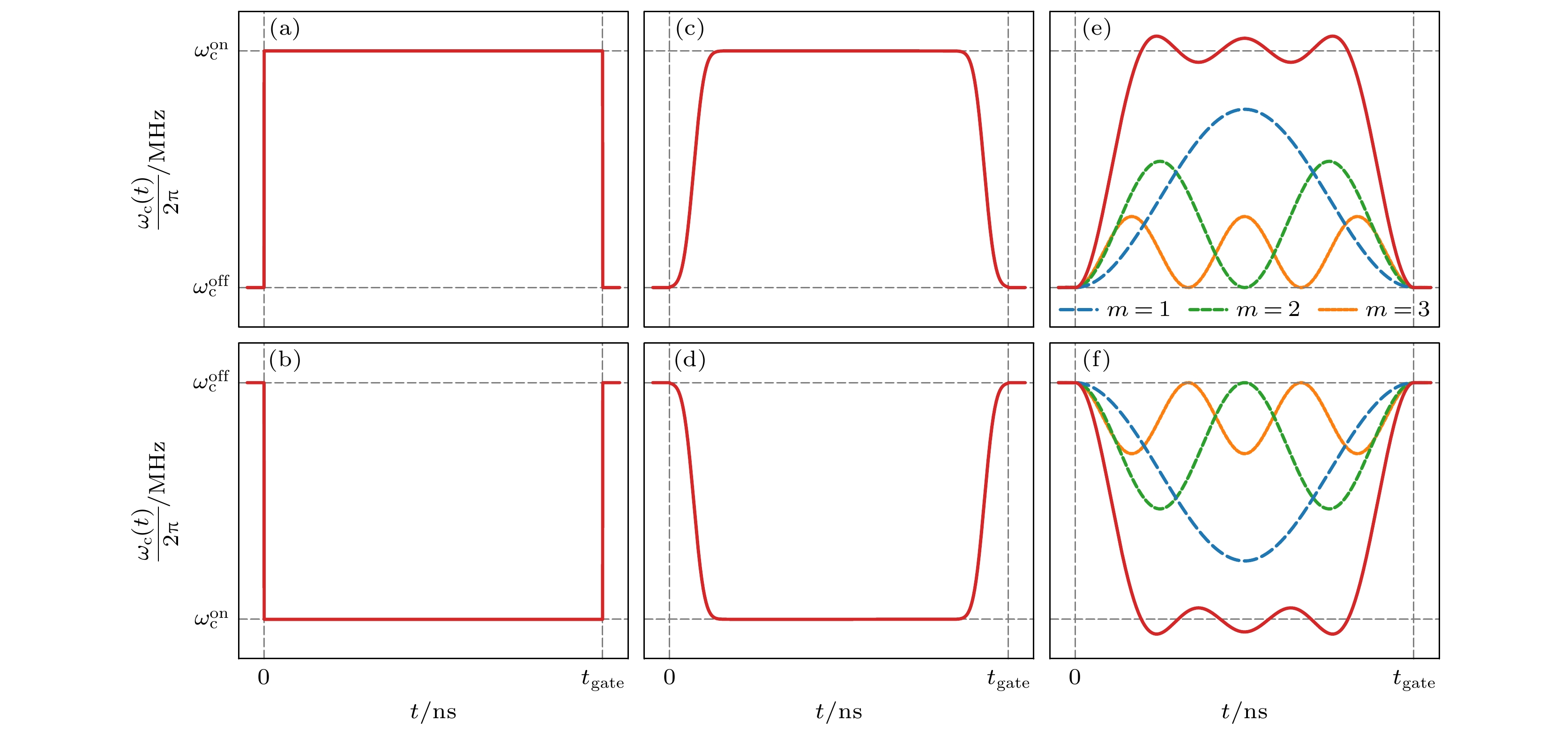
 DownLoad:
DownLoad:
